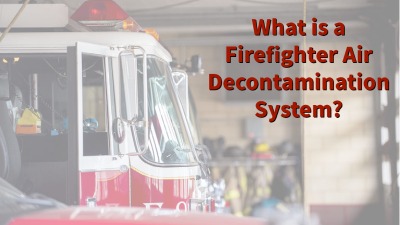What is a Firefighter Air Decontamination System?
https://www.youtube.com/watch?v=e-r65s05b68&list=PL-gw5C9iP0vbA_6M1ZxOos0w8q9JjEwbe&index=17&t=2s
As a firefighter or first responder, you take plenty of precautions to make sure you return home safely after a call. Using the proper gear on-scene is as important as ever, but what about in-cab and in-station after the call? Have you ever thought about using an air decontamination system to reduce cancer- and disease-causing contaminants in the air around you? If so, you have probably had the same thought as many others – what is air decontamination? How does it differ from other air filtration systems?
Here at Task Force Tips, we have built a reliable, high-quality, and comprehensive air decontamination and filtration system. Our products cover you in cab and at the station, and we want to make sure you know why that matters.
At the end of the day, protecting yourself and others is what you do. Cleaning the air to remove particulates, volatile organic compounds (VOCs), viruses, and bacteria is another step you can take to ensure everyone stays healthy. In this article we will help you understand what air decontamination is, why you might want a filter in your system, and why we feel our products are the most comprehensive on the market.
What is Air Decontamination?
Air decontamination is a method of cleaning the air and making it healthier for you to breathe. Air decontamination systems remove particulates, volatile organic compounds (VOCs), bacteria, and viruses through a series of filters or other technologies. It is important to realize that this is much more in-depth than air systems that do not have a filter and may rely on just a bulb or ionization. A comprehensive decontamination system will include at least one, if not multiple filters to catch particulates and other matter as it flows through the system. Without a filter, particulates will either stay airborne until caught or breathed in, or will fall onto surfaces over time.
Learn more about VOCs and particulates here!
Soot and the smell of smoke are common air contaminates for firefighters. These elements are considered volatile organic compounds (VOCs) and can be cancer-causing. VOCs cling to clothes and skin and continue to off-gas, or release back into the air, over time. Have you ever walked by your gear and smelled the fire from the night before? If so, you have experienced off-gassing. Air decontamination systems reduce the number of particles in the air that cause this smell. This enhances the air quality of the area while creating the added benefit of making it more pleasant to be in.
Decontamination systems also reduce bacteria and viruses in the air. When people live or sit in close quarters, it is more likely for bacteria and viruses to spread. These elements can also be introduced when you help a patient at the scene of a call or in the back of an ambulance. An air decontamination unit can quickly and effectively capture viruses and bacteria to reduce your chances of contracting a communicable disease.
The goal of air decontamination is to take a thorough approach to making the environment you are exposed to healthier. A comprehensive solution, such as the Task Force Tips CrewProtect or StationProtect, will have multiple filters or pieces of technology to clean the air you breathe. A filter is just one part of these air decontamination products. The added filters and stages make these systems capable of removing multiple threats from the apparatus cab or fire station, rather than focusing on just one or two threats like competing systems do. An additional benefit of the TFT solutions is that they create no harmful byproducts, like ozone or formaldehyde, while cleaning the air.
Looking for more information on air decon? Request your copy of the Guide to Understanding Emergency Services Air Decontamination here!
Aren’t Other Air Filtering and Cleaning Systems Good Enough?
The answer to this question depends on your goals for the system. If you are looking for something truly comprehensive that will reduce cancer-causing VOCs and particulates while also mitigating viruses and bacteria, you will want an air decontamination system that includes at least one filter. The CrewProtect and StationProtect products have cartridges that are replaced at certain intervals, and include filters, a high-end HEPA filter, and other technology to catch VOCs, particulates, and aerosols carrying viruses.
If you are only looking to clear a specific type of threat from the air, like viruses, a different system may work for you. Various technologies have been created to address air contamination, so it’s important to research the different solutions available and consider what they can remove from the air and how reliably they do so.
What Makes the TFT Air Decontamination Products Special?
CrewProtect and StationProtect are unique because they are built to reduce many of the air contaminants that firefighters face after a call or while back at the station. This comprehensive solution doesn’t just tackle viruses and bacteria, it also reduces particulates and volatile organic compounds that can cause cancer and other diseases. These systems were built with firefighter air contamination concerns in mind.
Other systems may seem like a good option because there are no filters to replace, or they use a bulb that needs to be changed less often. What these systems lack is a filter that can reliably capture different sized particles. That is why the TFT PuraShield cartridge has a prefilter, molecular filtration, antimicrobial filtration, and a HEPA filter to capture more than 99% of VOCs, particulates, and viruses from the air.
